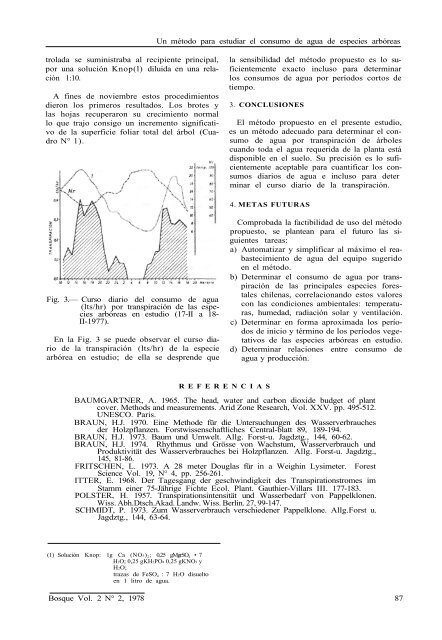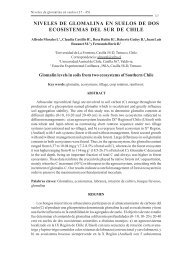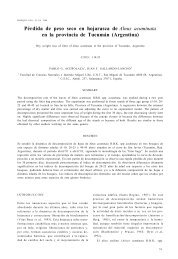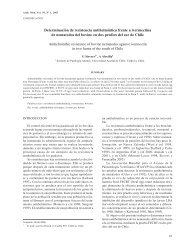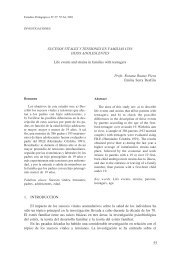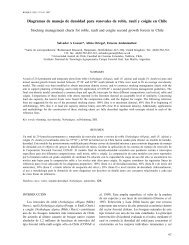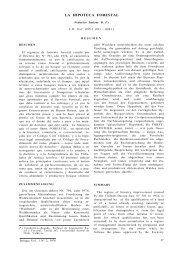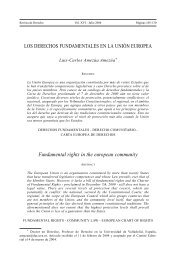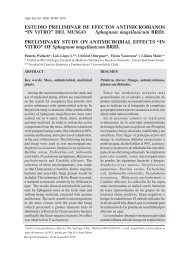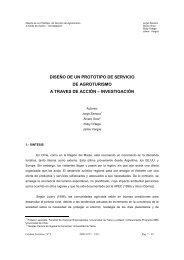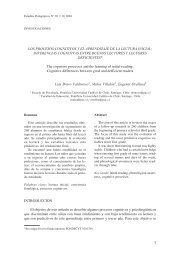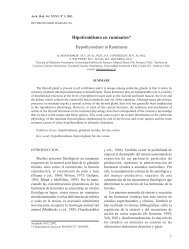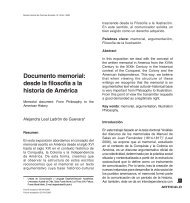un metodo para estudiar el consumo de agua de especies arboreas
un metodo para estudiar el consumo de agua de especies arboreas
un metodo para estudiar el consumo de agua de especies arboreas
You also want an ePaper? Increase the reach of your titles
YUMPU automatically turns print PDFs into web optimized ePapers that Google loves.
Un método <strong>para</strong> <strong>estudiar</strong> <strong>el</strong> <strong>consumo</strong> <strong>de</strong> <strong>agua</strong> <strong>de</strong> <strong>especies</strong> arbóreas<br />
trolada se suministraba al recipiente principal, la sensibilidad d<strong>el</strong> método propuesto es lo supor<br />
<strong>un</strong>a solución Knop(l) diluida en <strong>un</strong>a r<strong>el</strong>a ficientemente exacto incluso <strong>para</strong> <strong>de</strong>terminar<br />
ción 1:10.<br />
los <strong>consumo</strong>s <strong>de</strong> <strong>agua</strong> por períodos cortos <strong>de</strong><br />
tiempo.<br />
A fines <strong>de</strong> noviembre estos procedimientos<br />
dieron los primeros resultados. Los brotes y 3. CONCLUSIONES<br />
las hojas recuperaron su crecimiento normal<br />
lo que trajo consigo <strong>un</strong> incremento significati El método propuesto en <strong>el</strong> presente estudio,<br />
es <strong>un</strong> método a<strong>de</strong>cuado <strong>para</strong> <strong>de</strong>terminar <strong>el</strong> con<br />
sumo <strong>de</strong> <strong>agua</strong> por transpiración <strong>de</strong> árboles<br />
cuando toda <strong>el</strong> <strong>agua</strong> requerida <strong>de</strong> la planta está<br />
disponible en <strong>el</strong> su<strong>el</strong>o. Su precisión es lo suficientemente<br />
aceptable <strong>para</strong> cuantificar los <strong>consumo</strong>s<br />
diarios <strong>de</strong> <strong>agua</strong> e incluso <strong>para</strong> <strong>de</strong>ter<br />
minar <strong>el</strong> curso diario <strong>de</strong> la transpiración.<br />
vo <strong>de</strong> la superficie foliar total d<strong>el</strong> árbol (Cuadro<br />
N° 1).<br />
Fig. 3.— Curso diario d<strong>el</strong> <strong>consumo</strong> <strong>de</strong> <strong>agua</strong><br />
(lts/hr) por transpiración <strong>de</strong> las <strong>especies</strong><br />
arbóreas en estudio (17-II a 18-<br />
II-1977).<br />
4. METAS FUTURAS<br />
Comprobada la factibilidad <strong>de</strong> uso d<strong>el</strong> método<br />
propuesto, se plantean <strong>para</strong> <strong>el</strong> futuro las siguientes<br />
tareas:<br />
a) Automatizar y simplificar al máximo <strong>el</strong> reabastecimiento<br />
<strong>de</strong> <strong>agua</strong> d<strong>el</strong> equipo sugerido<br />
en <strong>el</strong> método.<br />
b) Determinar <strong>el</strong> <strong>consumo</strong> <strong>de</strong> <strong>agua</strong> por transpiración<br />
<strong>de</strong> las principales <strong>especies</strong> forestales<br />
chilenas, corr<strong>el</strong>acionando estos valores<br />
con las condiciones ambientales: temperaturas,<br />
humedad, radiación solar y ventilación.<br />
c) Determinar en forma aproximada los períodos<br />
<strong>de</strong> inicio y término <strong>de</strong> los períodos vege<br />
En la Fig. 3 se pue<strong>de</strong> observar <strong>el</strong> curso dia tativos <strong>de</strong> las <strong>especies</strong> arbóreas en estudio.<br />
rio <strong>de</strong> la transpiración (lts/hr) <strong>de</strong> la especie d) Determinar r<strong>el</strong>aciones entre <strong>consumo</strong> <strong>de</strong><br />
arbórea en estudio; <strong>de</strong> <strong>el</strong>la se <strong>de</strong>spren<strong>de</strong> que <strong>agua</strong> y producción.<br />
REFERENCIAS<br />
BAUMGARTNER, A. 1965. The head, water and carbon dioxi<strong>de</strong> budget of plant<br />
cover. Methods and measurements. Arid Zone Research, Vol. XXV. pp. 495-512.<br />
UNESCO. Paris.<br />
BRAUN, H.J. 1970. Eine Metho<strong>de</strong> für die Untersuch<strong>un</strong>gen <strong>de</strong>s Wasserverbrauches<br />
<strong>de</strong>r Holzpflanzen. Forstwissenschaftliches Central-blatt 89, 189-194.<br />
BRAUN, H.J. 1973. Baum <strong>un</strong>d Umw<strong>el</strong>t. Allg. Forst-u. Jagdztg., 144, 60-62.<br />
BRAUN, H.J. 1974. Rhythmus <strong>un</strong>d Grösse von Wachstum, Wasserverbrauch <strong>un</strong>d<br />
Produktivität <strong>de</strong>s Wasserverbrauches bei Holzpflanzen. Allg. Forst-u. Jagdztg.,<br />
145, 81-86.<br />
FRITSCHEN, L. 1973. A 28 meter Douglas für in a Weighin Lysimeter. Forest<br />
Science Vol. 19, N° 4, pp. 256-261.<br />
ITTER, E. 1968. Der Tagesgang <strong>de</strong>r geschwindigkeit <strong>de</strong>s Transpirationstromes im<br />
Stamm einer 75-Jährige Fichte Ecol. Plant. Gauthier-Villars III. 177-183.<br />
POLSTER, H. 1957. Transpirationsintensität <strong>un</strong>d Wasserbedarf von Papp<strong>el</strong>klonen.<br />
Wiss. Abh.Dtsch.Akad. Landw. Wiss. Berlin. 27, 99-147.<br />
SCHMIDT, P. 1973. Zum Wasserverbrauch verschie<strong>de</strong>ner Papp<strong>el</strong>klone. Allg.Forst u.<br />
Jagdztg., 144, 63-64.<br />
(1) Solución Knop: 1g Ca (NO3) 2 ; 0,25 gMgrSO 4 • 7<br />
H2O; 0,25 gKH2PO4 0,25 gKNO3 y<br />
H2O;<br />
trazas <strong>de</strong> FeSO 4 : 7 H2O disu<strong>el</strong>to<br />
en 1 litro <strong>de</strong> <strong>agua</strong>.<br />
Bosque Vol. 2 N° 2, 1978 87


